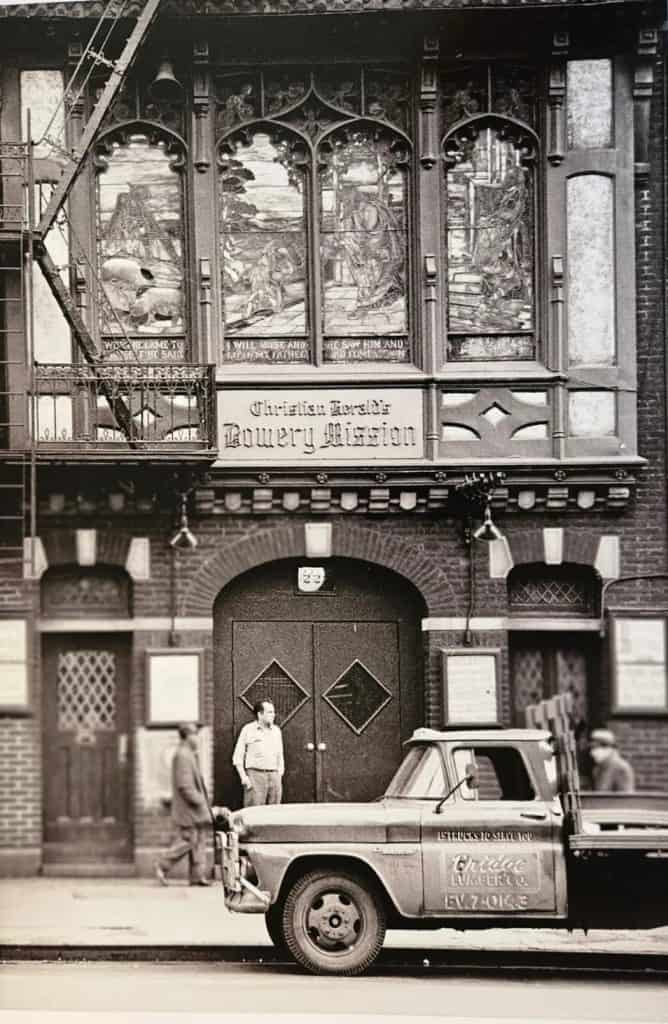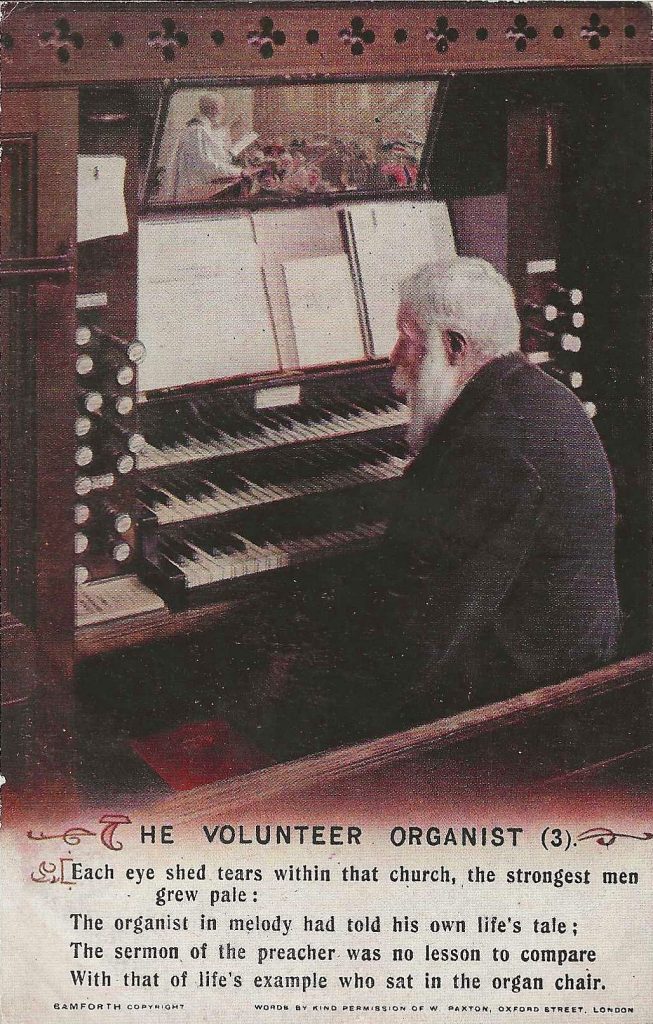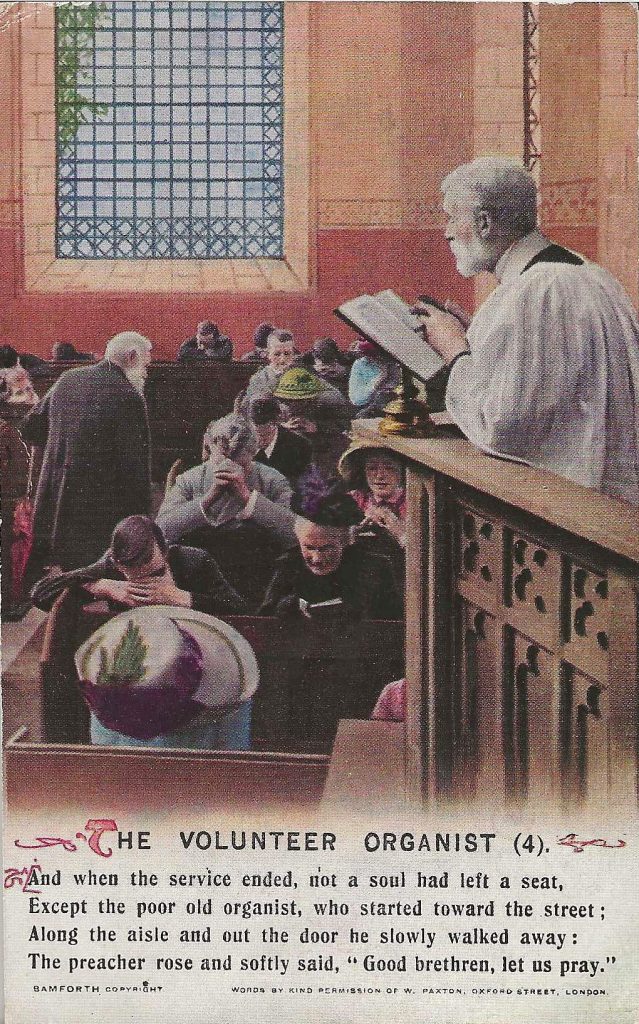Click the “play icon” to have Professor of Critical Musicology, Derek B. Scott of Leeds University sing this song for you. © 1980
The Volunteer Organist
I: The preacher in the village church one Sunday morning said:
Our organist is ill today, will someone play instead?
An anxious look crept o’er the face of every person there,
As eagerly they watched to see who’d fill the vacant chair.
A man then staggered down the aisle whose clothes were old and torn
How strange a drunkard seemed to me, in church on Sunday morn.
But as he touched the organ keys without a single word,
The melody that followed was the sweetest ever heard.
Refrain: The scene was one I’ll ne’er forget as long as I may live,
And just to see it o’er again, all earthly wealth I’d give;
The congregation all amazed, the preacher old and gray,
The organ and the organist who volunteered to play.
II: Each eye shed tears within that church, the strongest men grew pale;
The organist in melody had told his own life’s tale.
The sermon of the preacher was no lesson to compare
With that of life’s example who sat in the organ chair;
And when the service ended not a soul had left a seat,
Except the poor old organist, who started toward the street.
Along the aisle and out the door, he slowly walked away:
The preacher rose, and softly said, “Good brethren, let us pray.”
Refrain: The scene was one I’ll ne’er forget as long as I may live,
And just to see it o’er again, all earthly wealth I’d give;
The congregation all amazed, the preacher old and gray,
The organ and the organist who volunteered to play.
***
The use of pseudonyms by creative individuals of the 19th century was quite popular. In the simplest terms, the practice protected an author’s privacy.
Hymns were among the most common works to be composed anonymously and lyricized by pseudonymous writers. (If the work turned out to be offensive, it saved a lot of grief.)
On paper, the lyrics (or the poem) of The Volunteer Organist was written by W. B. Glenroy, whose given name was William B. Gray, and the music was composed by Henry Lamb, also a pseudonym used by Henry Spaulding.

The tale enjoys two origins: one British and one American. The American version is possibly based on a real incident at the Christian Herald Bowery Mission at 227 Bowery near Prince Street, in New York City. This mission has served its neighbors from the southeastern corner of Manhattan who have experienced homelessness and hunger since the 1870s, when the neighborhood came to define the term “skid row.”

A New York City Directory (for 1901) listing the residents of the Borough of Brooklyn, includes Victor H. Benke from 94 S. 2nd Street, as a musician. Research has proven that Benke was the organist at the Mission, and it was he who was ill on the Sunday when the mission preacher called for a volunteer and a disheveled old man stepped forward from the congregation to substitute for him.
Benke (or perhaps, Behnke) was born in Poland in July 1872. He was a well-educated musician who immigrated to America circa 1891. Although he was a sickly individual, he managed to find work as a freelance consultant in three (questionable) music publishing companies. He also wrote music, mostly hymns under his own name. The most popular of his works is the interdenominational hymn, God Cares for Me.
Victor H. Benke died on July 15, 1904, at age 32. A plaque that commemorates his service to the Mission hangs on a wall near the organ.
***
Peter Smith Dawson was an Australian songwriter and concert singer. He made his first recording in 1904 and was among the first to use the gramophone as an entertainment medium.
His repertoire was eclectic, he sang classical arias like Tchaikovsky’s Don Juan to folk songs such as Waltzing Matilda and almost everything in between.

Dawson recorded The Volunteer Organist in 1904 and it was he who made it a perpetual favorite. As a performer, he worked for over fifty years for EMI and HMV (early 20th century record companies.) In the 1920s and 1930s, he was possibly the most popular singer of the era. Once when asked about his recordings, he said, “I have enjoyed my years at the microphone, but when I think of my time at the gramophone, I remember how it was an instrument of torture. It was excruciating for the recording artist, who needed “lungs of leather” to make an impression on those wax cylinders. They captured nothing but the very loudest noises. I was lucky, I could make those kinds of noises.”
Dawson died in September 1961, but forty-one years later he became the subject of a biography, Peter Dawson: The World’s Most Popular Baritone written by Peter Burgis and Russell Smith. The authors suggest that Dawson made more than 1500 recordings during his career.
The Guinness Book of Recorded Sound chose Dawson, in 1984, as one of the top ten singers of all time. Others on that list were Elvis Presley and Enrico Caruso.
***
The four-postcard set was published by Bamforth as part of its “Song” series. The cards were sold in both England and New York. The artist seems to ascribe to the British version of the story.





As always, another great story from Ray.
I had never heard of Dawson until today, even though he was obviously prolific and popular in his time.
That’s a great story. I have those cards too and remember looking into some of this background at one time. It’s nice to see it written up so well. I wrote an article on some of my other Bamforth song sets: https://torontopostcardclub.com/first-world-war-songs-and-hymns-on-postcards/
This one resonates with me, as my day was from London and used to sing me British Music Hall songs. Very interesting cards as well. Thanks